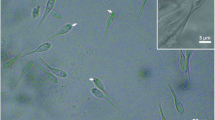Summary
The ultrastructure of trophic stage (plasmodium), spore and changes in fine structure during morphogenesis of the spore were studied by electron microscopy in two representatives of the genusSphaeromyxa. Plasmodium has a highly differentiated structure; there is an outer layer of homogeneous plasm, the endoplasm consisting of a vacuolated mass in which “float” generative cells and sporoblasts in different degree of development. Generative cells have well developed pseudopodia. Sporoblasts arise from the union of two cells, out of which the inner one forms all cells of the spore, the outer one has only an enveloping function. Polar capsule develops in a way identical with other myxosporidia; the wide filament, however, has a longitudinally folded structure and is located within the capsule in two loose loops. The mitochondria of an early sporoblast are characterized by a high content of DNA. The identity of polar capsule development with the nematocyst morphogenesis is too conspicuous to be taken for a mere convergence. Studies on ultrastructure give no evidence for a protozoan character of myxosporidia; together with other findings, they are in favor of the nonprotozoan nature of this group of organisms.
Similar content being viewed by others
References
André, J.: Données récentes sur la physiologie des mitochondries. C. R. Soc. Biol. (Paris)162, 7–12 (1968).
Cheissin, E. M., S. S. Shulman, andL. P. Vinnitchenko: Stroenie sporMyxobolus. Tsitologia3, 662–667 (1961).
Grassé, P. P.: Les Myxosporidies sont des organismes pluricellulaires. C. R. Acad. Sci. (Paris)251, 2638–2640 (1960).
Grell, K. G.: Protozoologie, pp. VII+284. Berlin-Göttingen-Heidelberg: Springer 1956.
Honigberg, B. M. (Chairman): A revised classification of the phylum Protozoa. J. Protozool.11, 7–20 (1964).
Issi, I. V., andS. S. Shulman: On the systematic position of the microsporidia. [Russian.] Parazitologia1, 151–157 (1967).
Lentz, T. L.: Rhabdite formation inPlanaria: The role of microtubules. J. Ultrastruct. Res.17, 114–126 (1967).
Lom, J.: Notes on the extrusion and some other features of myxosporidian spores. Acta protozool.2, 321–327 (1964).
—, andJ. O. Corliss: Ultrastructural observations on the development of the microsporidian protozoonPlistophora hyphessobryconis Schäperclaus. J. Protozool.14, 141–152 (1967).
—, andP. de Puytorac: Observations sur l'ultrastructure des trophozoites de myxosporidies. C. R. Acad. Sci. (Paris)260, 2588–2590 (1965a).
— —: Studies on the myxosporidian ultrastructure and polar capsule development. Protistologica1, 53–65 (1965b).
—, andJ. Vávra: A proposal to the classification of the subphylum Cnidospora. Syst. Zool.11, 172–175 (1962).
— —: Pine morphology of the spore in Microsporidia. Acta protozool.1, 280–283 (1963).
- - Parallel features in the development of myxosporidian polar capsules and coelenterate nematocysts. Proc. III. Europ. Reg. Conf. on Electron Microscopy, p. 191–192 (1964).
— —: Notes on the morphogenesis of the polar filament inHenneguya (Protozoa, Cnidospora). Acta protozool.3, 57–60, 1965.
Manier, J. F., etR. Ormières: Ultrastructure de quelques stades deChytridiopsis socius Shnc. parasite deBlaps lethifera Marsh. (Coleopt. Tenebr.). Protistologica4, 181–185 (1968).
Parsons, J. A.: The division of mitochondrial DNA inTetrahymena pyriformis. J. Cell Biol.23, 70 A (Suppl.), (1964).
Reynolds, E. S.: The use of lead citrate at high pH as an electron-opaque stain in electron-microscopy. J. Cell Biol.17, 208–212 (1963).
Schubert, G.: Elektronenmikroskopische Untersuchungen zur Sporenentwicklung vonHenneguya pinnae Schubert (Sporozoa, Myxosporidea, Myxobolidae). Z. Parasitent.30, 57–77 (1968).
Shulman, S. S.: The myxosporidian fauna of the USSR. [Russian.] 504 pp. Moscow-Leningrad: Publ. House Nauka 1966.
Slautterback, D. B.: Cytoplasmic microtubules I.Hydra. J. Cell Biol.18, 367–388 (1963).
—, andD. W. Fawcett: The development of the cnidoblasts ofHydra. An electron microscopic study of cell differentiation. J. biophys. biochem. Cytol.5, 411–430 (1959).
Sprague, V.: Suggested changes in: “A revised classification of the phylum Protozoa”, with particular reference to the position of the haplosporidians. Syst. Zool. 345–349 (1966).
Stone, G. E., andO. C. Miller Jr.: A stable mitochondrial DNA inTetrahymena pyriformis. J. exp. Zool.159, 33–38 (1965).
Uspenskaya, A. V.: On the mode of nutrition of vegetative stages ofMyxidium lieberkühni (Bütschli). [In Russian, English summary.] Acta protozool.4, 81–89 (1966).
Vávra, J.: Etude au microscope éléctronique de la morphologie et du développement de quelques microsporidies. C. R. Acad. Sci. (Paris)261, 3467–3470 (1965).
— etP. de Puytorac: Observations sur l'ultrastructure du filament polaire des microsporidies. Protistologica2, 109–112 (1966).
Westfall, J. A.: The differentiation of nematocysts and associated structures in the Cnidaria. Z. Zellforsch.75, 381–403 (1966).
Author information
Authors and Affiliations
Additional information
The essential part of this work was carried out in the Department of Biology, University of Illinois at Chicago Circle, where this study was aided by a grant from the National Science Foundation (NSF GB-2800) to Dr.J. Corliss. The author is also indebted to Dr.R. Fernald, University of Washington, for the use of all facilities at the Friday Harbour Laboratories of the University of Washington.
Rights and permissions
About this article
Cite this article
Lom, J. Notes on the ultrastructure and sporoblast development in fish parasitizing myxosporidian of the genusSphaeromyxa . Z.Zellforsch 97, 416–437 (1969). https://doi.org/10.1007/BF00968848
Received:
Issue Date:
DOI: https://doi.org/10.1007/BF00968848




